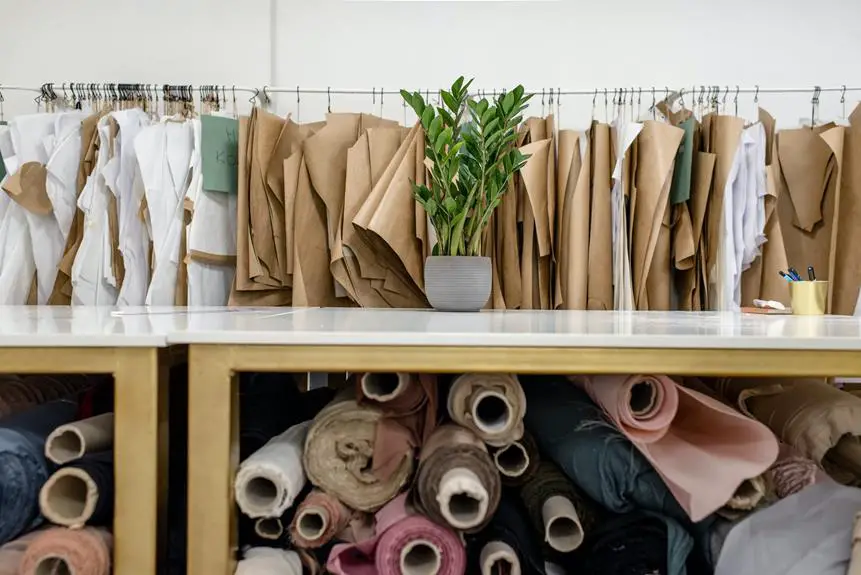When you curl up on the couch on a chilly evening, you want the cosiest fabric to keep you warm. Imagine slipping into a pair of fleece pajamas after a long day at work. They feel soft, plush, and incredibly warm against your skin.
Now, picture wrapping yourself in a flannel blanket while reading a book by the fireplace. It's smooth, comforting, and provides a gentle warmth.
In this comparison, you'll explore the characteristics of fleece and flannel to determine which fabric is cosier. From softness and warmth to comfort and durability, you'll uncover the qualities that make each fabric unique.
So, which one will become your go-to choice for ultimate cosiness?
Key Takeaways
- Fleece is known for its warmth, softness, moisture-wicking properties, and lightweight nature, while flannel excels in warmth, softness, and insulation.
- Fleece provides an ultra-soft and plush feel, while flannel offers a softer, smoother texture.
- Fleece provides greater warmth and insulation compared to flannel, making it ideal for cold weather, while flannel is suitable for milder days.
- Fleece is more durable and resistant to wear and tear, making it suitable for outdoor activities, while flannel can maintain its quality and softness over time with proper care.
Characteristics of Fleece
Fleece fabric is known for its warmth, softness, and moisture-wicking properties, making it a popular choice for cozy winter wear. The softness of fleece comes from its texture, which is gentle on the skin and provides a luxurious feeling. This makes it a sought-after material for blankets, sweaters, and jackets.
In addition to its softness, fleece provides excellent insulation, trapping heat and keeping you warm even in chilly weather. Its ability to retain body heat makes it an ideal choice for outdoor activities or simply lounging at home.
Comfort is another standout feature of fleece. Its plush feel and lightweight nature make it incredibly comfortable to wear. Whether you're layering up for a winter hike or snuggling on the couch, fleece offers a level of comfort that's hard to beat. Furthermore, fleece is breathable, allowing air to circulate and preventing overheating. This breathability makes it suitable for a wide range of activities, from casual strolls to intense workouts.
Characteristics of Flannel
When it comes to the characteristics of flannel, you'll find that it excels in both warmth and softness. Its unique texture provides a cozy and comfortable feel, making it a popular choice for chilly nights.
Additionally, flannel is known for its breathability and durability, making it a versatile fabric for a variety of uses.
Flannel Warmth and Softness
You'll find that flannel fabric retains warmth exceptionally well while providing a soft and comfortable feel against your skin. It's the perfect choice for those chilly nights when you want to feel snug and cosy.
Here's why flannel is a top pick for warmth and softness:
- Insulating Properties: Flannel's brushed surface traps air, creating a natural insulation layer that helps to keep you warm without feeling bulky. This makes flannel an excellent alternative to wool, offering comparable warmth without the itchiness often associated with wool garments.
- Supreme Softness: The brushing process used to create flannel results in a fabric that's not only warm but also incredibly soft against your skin, making it a delight to wear.
With its exceptional insulating properties and supreme softness, flannel is the go-to choice for those seeking warmth and comfort without sacrificing style.
Flannel Breathability and Durability
Flannel's breathability and durability make it a practical choice for those seeking a comfortable and long-lasting fabric option.
The natural fibers in flannel allow air to circulate, preventing overheating and ensuring a cool and breathable feel against your skin. This breathability makes flannel an excellent choice for year-round wear, keeping you cozy in winter without feeling stifling in warmer temperatures.
Additionally, flannel is known for its exceptional durability, making it a fabric that can withstand regular wear and washing. Its moisture-wicking properties also contribute to its longevity by resisting pilling and maintaining its softness over time.
With minimal maintenance, flannel can retain its quality for years, making it a reliable and enduring choice for your wardrobe.
Flannel Vs. Fleece
Consider the characteristics of flannel when deciding between it and fleece for your next cozy purchase. When it comes to the winter fabric showdown of flannel vs fleece, it's essential to understand the unique qualities of flannel:
- Natural Insulation: Flannel is known for its excellent insulating properties, making it a perfect choice for colder climates and winter nights.
- *Breathability:* Unlike fleece, flannel is highly breathable, allowing for airflow while still retaining warmth, ensuring you stay comfortable.
- *Durability:* Flannel fabric is robust and long-lasting, standing the test of time and maintaining its coziness after numerous washes.
Understanding these characteristics can help you make an informed decision when choosing between flannel and fleece for your next cozy addition to your wardrobe.
Softness Comparison
When comparing softness, consider the tactile appeal of fleece and flannel against your skin. Both fabrics offer a different experience on the softness scale due to their unique fabric texture.
Fleece, known for its ultra-soft and plush feel, often provides a luxurious and velvety sensation against the skin. Its texture is reminiscent of a cozy blanket, making it incredibly inviting and comforting.
On the other hand, flannel boasts a softer, smoother texture that offers a gentle and soothing touch. It provides a subtle warmth and a comforting embrace that many find irresistible.
The softness of fleece and flannel can be subjective, as personal preferences play a significant role in determining which fabric feels cosier to you. Some may prefer the silky smoothness of flannel, while others may gravitate towards the cloud-like softness of fleece. Ultimately, the choice between the two comes down to individual preferences and the specific tactile experience you seek.
Whether it's the plushness of fleece or the smoothness of flannel, both fabrics offer an indulgent softness that enhances the overall coziness of your attire or bedding.
Warmth Comparison
When it comes to warmth, you want a fabric that not only keeps you cozy but also provides insulation.
In this discussion, we'll compare the warmth, insulation, and overall comfort that fleece and flannel offer.
Understanding the differences in these aspects will help you make an informed decision about which fabric is cosier for your needs.
Fleece Vs Flannel Warmth
You may notice that fleece tends to provide a greater level of warmth compared to flannel. This is due to the nature of the fabric and its ability to trap heat more effectively. Here's a deeper look at the warmth comparison between fleece and flannel:
- Fleece:
- Fleece is made from synthetic materials such as polyester, which have insulating properties, making it an excellent choice for winter wear.
- Its lofted construction creates air pockets that retain body heat, keeping you warm and cozy in cold weather.
- Flannel:
- Flannel, while warm, isn't as insulating as fleece due to its woven construction, which allows more air circulation.
- It's a suitable choice for milder winter days or as a layering piece, but may not provide the same level of warmth as fleece in extremely cold conditions.
Insulation and Comfort
Comparing the insulation and comfort of fleece and flannel, it's important to consider their respective warmth-retaining abilities and overall coziness.
Fleece, known for its exceptional insulation properties, provides a higher level of warmth compared to flannel. The structure of fleece fabric creates air pockets that trap heat, making it an excellent choice for chilly weather. Its soft, fuzzy texture contributes to a high comfort level, offering a cozy and snug feeling.
On the other hand, flannel, while also providing good insulation, may not be as effective as fleece in extreme cold due to its looser weave. However, flannel's brushed surface adds to its coziness, making it a popular choice for comfortable loungewear.
When comparing the comfort level and insulation of fleece and flannel, it's clear that both fabrics offer warmth, with fleece excelling in extreme cold and flannel providing a comfortable, cozy feel.
Comfort and Durability
As you consider the choice between fleece and flannel, it's important to evaluate their comfort and durability.
When it comes to comfort, both fleece and flannel have their own unique qualities. Fleece is incredibly soft and provides excellent insulation, making it a popular choice for cold weather. On the other hand, flannel is known for its cozy, brushed texture that offers a comfortable and breathable feel against the skin.
In terms of fabric durability, it's essential to take into account how often and in what conditions you'll be using the fabric. Considering durability, fleece is often more resistant to wear and tear, making it a durable option for outdoor activities and frequent use. Conversely, flannel, when properly cared for, can maintain its quality and softness over time, making it a durable choice for everyday wear and home furnishings.
Ultimately, the decision between fleece and flannel depends on your specific comfort needs and the intended use of the fabric.
Choosing the Right Fabric
When selecting between fleece and flannel, prioritize your specific needs for warmth and breathability. Both fabrics offer cosy comfort, but understanding the nuances can help you make the right choice for your winter clothing.
Fleece, known for its exceptional warmth, is a great option for those seeking to stay toasty in cold weather. It's a breathable fabric that wicks moisture away from the body, making it an excellent choice for outdoor activities in chilly conditions.
On the other hand, flannel, while also providing warmth, offers a more breathable option compared to fleece. Its ability to trap body heat without causing overheating makes it a versatile choice for various indoor and outdoor settings.
When choosing fabric for your winter clothing, consider the activities you'll be engaging in and the level of warmth and breathability required. Whether you opt for fleece or flannel, both fabrics offer exceptional comfort, and understanding their unique characteristics will help you make an informed decision for your winter wardrobe.
Frequently Asked Questions
Can Fleece or Flannel Fabrics Be Used for Outdoor Activities Like Camping and Hiking?
For outdoor activities like camping and hiking, both fleece and flannel are great for layering options and insulation. Fleece offers durability and moisture-wicking, while flannel provides a cozy and breathable option. Both fabrics have their distinct benefits for outdoor adventures.
Are There Any Environmental Considerations When Choosing Between Fleece and Flannel?
When choosing between fleece and flannel, consider the environmental impact, sustainability, and ethical production. Look for fabric customization and eco-friendly dyeing options. These factors contribute to a more conscious and responsible purchase.
How Do Fleece and Flannel Fabrics Hold up in Terms of Pilling and Shedding?
To prevent pilling, choose high-quality fleece or flannel. Look for tightly woven fabrics and consider brushed finishes. Control shedding by washing in cold water and using a gentle cycle. Avoid over-drying to maintain fabric integrity.
Which Fabric Is More Suitable for People With Sensitive Skin or Allergies?
For sensitive skin and fabric allergies, both fleece and flannel can be cozy options. Consider the texture and breathability of each fabric. Fleece may feel softer, while flannel's natural fibers could be gentler on your skin.
Can Fleece and Flannel Fabrics Be Easily Dyed or Customized?
Yes, fleece and flannel fabrics can be easily dyed or customized. Customization options allow for personalization, while the dyeing process offers flexibility to match your preferences. Both fabrics offer versatility in creating unique, personalized pieces.
- Why Is Red Velvet Not Red? - April 25, 2024
- How Do You Describe Velvet Fabric? - April 25, 2024
- How Strong Is Velvet? - April 25, 2024






